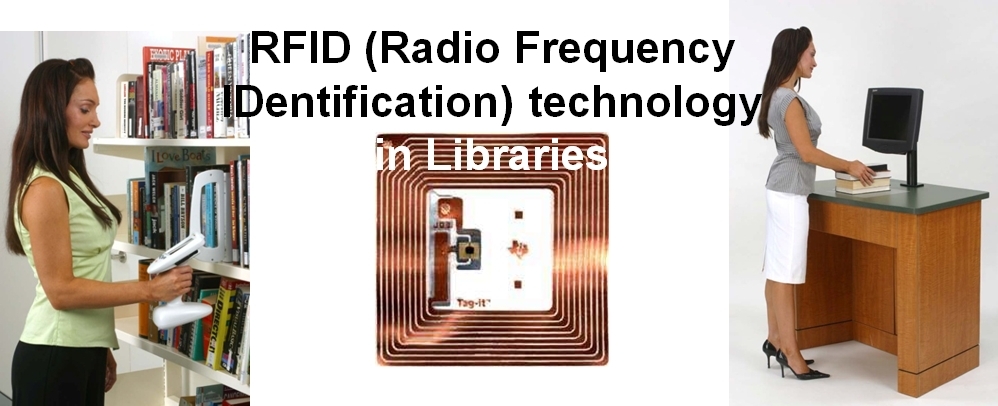
RFID (Radio Frequency IDentification) technology in
Libraries
RFID
(Radio Frequency IDentification) is the latest technology to be used in library theft detection systems. Unlike EM
(Electro-Mechanical) and RF (Radio Frequency) systems, which have been used in libraries for decades, RFID-based
systems move beyond security to become tracking systems that combine security with more efficient tracking of
materials throughout the library, including easier and faster charge and discharge, inventorying, and materials
handling.
RFID is a combination of radio-frequency-based technology and microchip technology. The information contained on
microchips in the tags affixed to library materials is read using radio frequency technology regardless of item
orientation or alignment (i.e., the technology does not require line-of-sight or a fixed plane to read tags as do
traditional theft detection systems)
The tags used in RFID systems can replace both EM or RF theft detection tags and barcodes.
Libraries making use of RFID technology in South Africa:
There isn’t an
operational installation in South Africa accept for UNISA – University of South Africa
What is it and
how does it work?
Radio Frequency IDentification
(RFID) is the use of an object (typically referred to as an RFID tag) applied to or incorporated into a product,
animal, or person for the purpose of identification and tracking using radio waves. Some tags can be read from
several meters away and beyond the line of sight of the reader.
RFID comprises interrogators
(also known as readers), and tags (also known as labels).
Most RFID tags contain at least
two parts. One is an integrated circuit for storing and processing information, modulating and demodulating a
radio-frequency (RF) signal, and other specialized functions. The second is an antenna for receiving and
transmitting the signal.
There are generally three types
of RFID tags: active RFID tags, which contain a battery and can transmit signals autonomously, passive RFID
tags, which have no battery and require an external source to provoke signal transmission, and battery assisted
passive (BAP) which require an external source to wake up but have significant higher forward link capability
providing great read range.
A library RFID tag has
information (data) encoded on the tag that contains a microchip and an antenna. The information is accessed by
the reader. The physical tag is a couple of inches square and very thin. It has no batteries or power source as
the energy needed to power and read the tag comes from the reader, which emits a signal that searches for a tag
within its limited (±18 inches) range. When the signal hits the tag, the tag awakens and
responds.
RFID has many
applications:
RFID has many
applications/uses, for example:
-
Asset management and retail
sales
-
Payment by mobile phones
-
Promotion tracking (tracking of
goods)
-
Access management
-
Transportation payments (toll
roads)
-
Public transit (bus, rail,
subway)
-
Machine readable travel
documents
-
Airport Baggage Tracking
Logistics
-
Museums
-
Tracking Sports memorabilia to verify
authenticity
-
Animal identification and
tracking
-
Human implants, etc.
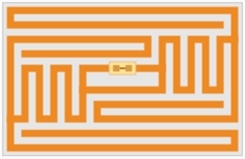
The near
Future
RFIDs are easy to conceal or incorporate in other items. For example, in 2009 researchers at
Bristol University successfully glued RFID micro transponders to live ants in order to study their behaviour.
This trend towards increasingly miniaturized RFIDs is likely to continue as technology advances. However, the
ability to read at distance is limited by the inverse-square law.
RFID tags used in
Libraries
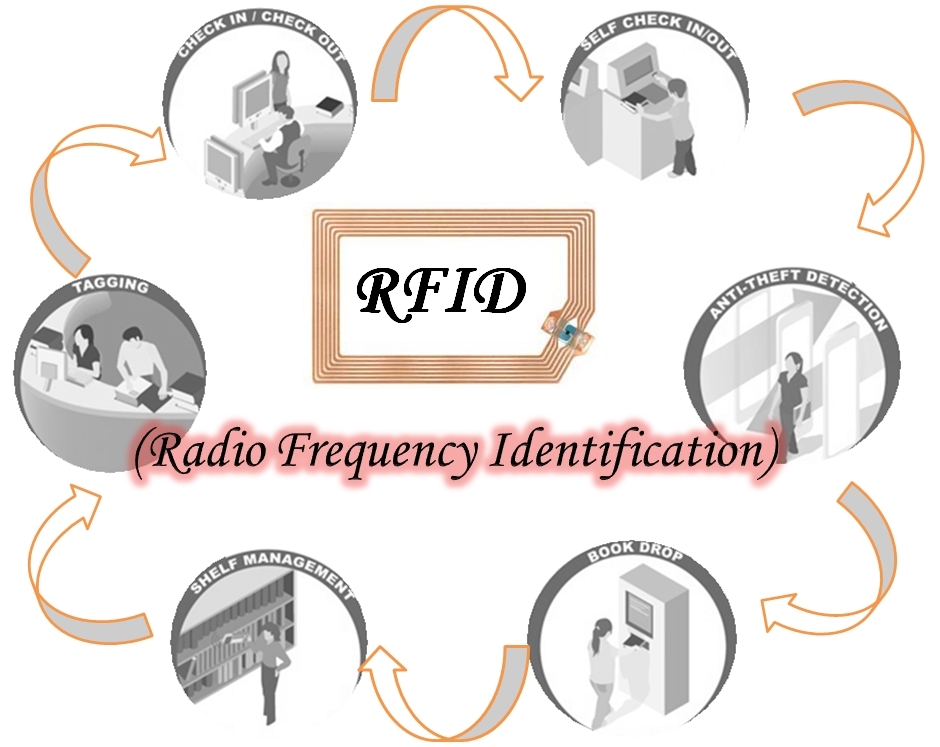
Among the many uses of RFID
technology it is also deployed libraries. While there is some debate as to when and where RFID in libraries
first began, it was first proposed in the late 1990s as a technology that would enhance workflow in the
library.
Worldwide, RFID is used most in
the United States, followed by the United Kingdom and Japan. It is estimated that over 30 million library items
worldwide now contain RFID tags.
As mentioned, RFID technology is
being implemented in a number of industries. Supply chain/retail sales implementation is perhaps one of the most
frequently mentioned applications of RFID tags and equipment. There is, however, a key difference to the
library’s use for RFID technology as compared to that of a warehouse or a supply chain/retail outlet. In the
warehouse and retail supply chain, goods come in and leave. Only occasionally are they returned. The retail
sector is looking at RFID as a "throwaway" technology that hands an item to a customer which gets discarded. Yet
the item wise unit cost of including an RFID tag is much more than the cost of printing a barcode on a package.
In libraries, items are taken out and returned many times. Thus the same RFID tag is re-used many
times.
The libraries started to use
RFID to speed up the self check in/out processes, to control the theft and to ease the inventory control in
libraries. The barcode technology is slowly getting replaced by the RFID technology. The RFID tag does not have
to be visible for detection. It can be read even when it is embedded in an item.
Benefits/Advantages of RFID
Technology
Reasons for a Library to
Invest in RFID Technology
Radio Frequency IDentification
(RFID) technology is an investment for libraries. To decide if the rewards justify making this investment,
library management must look at the benefits:
-
It may have potential savings because a
single tag serves many different functions
-
It may have potential savings due to
the integration of circulation and security with a single vendor and into a single system
-
A library saves some time in processing
new items because it only has to affix one technology to the item
-
And not only the books, but also the
membership cards could be fitted with an RFID tag
-
Most RFID tags are guaranteed for the
life of the item they’re affixed to
-
An RFID based Library Management system
(LMS) would allow fast transaction flow for the library and will provide immediate and long term
benefits to the library in traceability and security. (Rapid charging/discharging - The other time
savings realized by circulation staff are modest unless the RFID tags replace both the EM security
strips or RF tags of older theft detection systems and the barcodes of the automated library system -
i.e., the system is a comprehensive RFID system that combines RFID security and the tracking of
materials throughout the library; or it is a hybrid system that uses EM for security and RFID for
tracking, but handles both simultaneously with a single piece of equipment.)
-
RFID has many library applications that
can be highly beneficial, particularly for circulation staff. Since RFID tags can be read through an
item, there is no need to open a book cover or DVD case to scan an item. This could reduce
repetitive-motion injuries (repetitive stress problems)
-
Self-service system and RFID, patrons
can check out multiple items at once. This means they spend less time waiting in line at the
self-service station or the circulation desk = customer satisfaction
-
Accessing number of books at a time:
Where the books have a barcode on the outside, there is still the advantage that borrowers can scan an
entire pile of books in one go, instead of one at a time. (The anti-collision algorithm allows an
entire stack of items to be charged or discharged)
-
Searching a particular book to check
its presence in the library locating the physical location of the book: RFID could be used to aid a
librarian in locating where an item (e.g., book or magazine) is located. Example, if a book ID no. is
directly given as a searching parameter the beep sound will be given as soon as the particular book is
identified.
-
Shelf management – RFID items are more
likely to be shelved accurately, which increases customer convenience and reduces frustration
-
Accounting/Stock verification of the
materials
Next to these
readers with a fixed location there can also portable ones for librarians (RFID hand-held reader). With
these, inventories could be done on a whole shelf of materials within seconds, without a book ever
having to be taken off the shelf. It is possible not only to update the inventory, but also to identify
items which are out of proper order. The RFID can reduce the stocktaking time from months to weeks and
in small library to half a day
-
Also, the tasks that RFID takes over
are largely not the primary tasks of librarians. Most borrowers are pleased with the fact that staff
are now more available for answering questions
-
The RFID tag also acts as a security
device/ theft deterrent system, taking the place of the more traditional electromagnetic security
strip. RFID can be used in library anti-theft systems e.g., 3M tattle-tape security strips and
Sensormatic electronic security tags
-
RFID taking a large burden off staff
could also mean that fewer staff will be needed, resulting in some of them getting fired, but that has
so far not happened in most instances. Recent surveys have shown that library’s have not cut staff
because of adding RFID
-
RFID readers are highly reliable (RFID
library systems claim an almost 100 percent detection rate using RFID tags)
-
Long tag life - RFID tags last longer
than barcodes because nothing comes into contact with them. Most RFID vendors claim a minimum of
100,000 transactions before a tag may need to be replaced
Lastly, for many patrons the
greatest benefit comes from more interaction with the library staff. When librarians spend less time on routine
physical tasks, they can pay more attention to the needs of the library users.
In some libraries, the
installation of an RFID system has allowed librarians to provide e.g., language training, ICT training, to
create new programming for children and seniors and to address other evolving community needs.
RFID Technology
Challenges
Some librarians still haven’t made the decision to go forward with an RFID
installation.
Here are some of the reasons why:
Cost/Expense
Some librarians like the idea of
installing an RFID system, but they want to wait for another year (or two) before making the investment, hoping
that prices will come down. Most librarians believed that this technology is still too expensive to be feasible
in the library environment. The cost of upgrading from the old bar-coded items to RFID tags is well beyond the
reach of most library budgets, and however remains too costly for many smaller libraries in South
Africa.
The actual cost of RFID
Equipment and parts to any library will depend on which RFID equiptment the library uses.
-
Conversion
station – Where library
data is written to the tags. Conversion Station with Software
±R300,000-00
-
Staff workstation at
circulation – Used to
check-in and check-out materials. Staff Workstation with Software ±R94,000-00
-
Patron self check-out/in
station – Used to
check-out books without staff assistance. SelfCheck (+ software), solid top cabinet R360,000-00 to
R402,000-00
-
Book-drop
reader – Checks in
books when patrons drop them in the book-drop (Return station)
-
Sorting
station - Automated
system for returning books to proper area of library
-
Portable reader – Hand-held reader for inventorying and verifying that
items are shelved correctly. Hand held scanner and Data Manager (including
software) ±R190,000-00
-
Portable
Computer - Notebook PC
or PDA
-
Inventory & Searching software
- Software for
controlling the hardware and decoding the responses from tags in the interrogation zone
-
Tags
(usually supplied in a rolls -
1000 RFID tags in a roll) e.g., D5 RFID tags @ ±R 5,210-00 per 1000 (±R
5,21 each)
-
Anti-theft Detection Gate (Exit
sensors) – Verify that
all books leaving the library have been checked out
Installation and Training Costs
Installation and training – ±R18,000-00
(depending on location)
Hardware Warranty
One-year maintenance agreement (extended
warranty) ±R40,200-00 (Normal warranty: three months)
Two
services per annum plus unlimited call-outs. Includes travel, labour and parts.
# The above prices are
estimates and should only be used as a rough guide.
Take note that most suppliers are not local and therefore price are based on the rand/dollar exchange
rate.
Disruption
Occasionally, a librarian will
acknowledge that an RFID system is a good or even an inevitable improvement; with obvious benefits for staff and
customers—but the conversion process would be just too disruptive right now.
The time to convert a library will vary based on the efficiency/proficiency of a library’s conversion operators,
the physical configuration of the stacks (height and aisle space), bar-code locations, etc. The conversion period
has been estimated at ±6 months for an average-size library.
Security
Shielding: Does
aluminium foil block RFID chip signals?
In most cases aluminium foil
does not stop RFID (performance varies with respect to the vendors of RFID readers and tags). Yes, many have
claimed that RFID tags can easily be shielded by a few sheets of aluminium foil, so that they won’t be detected
by the reading device. However, if an item has a RFID chip inside it, and you covered the entire item with
aluminium foil (with aluminium covering the entire surface area), the reader in most cases will still beep
because it could detect the item.
The aluminium foil does help
with preventing the card from transmitting. Without the aluminium foil, an item can be detected by the reader at
a distance. With the aluminium foil, the item was not easily detected until it was near the reader.
This does provide evidence that
aluminium foil can be used to substantially hinder RFID, but it is important note that aluminium foil did not
actually shield/block the RFID tag completely (only makes transmission more difficult, yet is not completely
effective at preventing it).
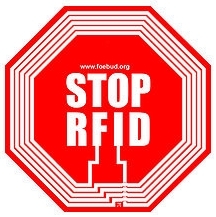
Privacy
issues/Controversies and concerns
Some librarians
and citizens privacy issues are pre-eminent.
A concern
surrounding RFID tags, also referred to as "spychips" in libraries that has received considerable publicity is the
issue of privacy. Because RFID tags can, depending on the RFID transmitter & reader, be scanned and read from
up to 80 meters (e.g., Smart Label RFID's) there is some concern over whether sensitive information could be
collected from an unwilling source (referred to as “tracking” and “hotlisting”).
“Tracking” - refers to the ability track the movement of a book (or person carrying the book)
“Hotlisting” - refers to process of building a database of books and their associated tag numbers
(the hotlist) and then using an unauthorized reader to determine who is checking out items
on the hotlist.
Most concerns
revolve around the fact that RFID tags affixed to the items/materials loaned from the library remain functional
even after the item(s) have been purchased and taken home and thus can be used for surveillance and other purposes
unrelated to the library functions.
However, the
high-frequency tags used in library items cannot normally be read at a distance of more than three or four feet. In
rare instances, they might be picked up at five or six feet.
Also worth
mentioning is the fact that library RFID tags usually do not contain any patron information, and the tags used in
the majority of libraries use a frequency only readable from approximately two to four feet. Also, libraries have
always had to keep records of who has borrowed what, so in that sense there is nothing new.
Lastly, it also
should be mentioned that current conventional wisdom suggests that privacy risks are negligible unless an adversary
has access to library databases as most tags will only carry the item ID, thus protecting the patron/users
privacy.
RFID Equipment & Parts
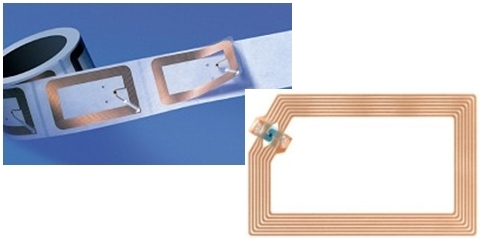
RFID tag (also
known as a transponder)
Tags can be passive, active or semi-active. An active tag contains some type of power source on the tag, whereas
the passive tags rely on the radio signal sent by the reader for power. Most RFID applications today utilize
passive tags because they are so much cheaper to manufacture
An RFID tag is the most
important link in any RFID system. It has the ability to store information relating to the specific item to
which they are attached, rewrite again without any requirement for contact or line of sight. Data within a tag
may provide identification for an item, proof of ownership, original storage location, loan status and history.
RFID Tag consists of an
integrated circuit and an antenna combined to form a transponder. RFID tags collect the energy to operate from a
Radio Frequency (RF) field emitted by a reader device; therefore they do not need a battery. When energized by a
radio signal from a fixed position reader or handheld scanner, the tag returns the stored information in order
that the item to which it is attached can be easily located.
The chip also has a "multi-read"
function, which means that several tags can be read at once.
RFID tags have been specifically
designed to be affixed into library media, including books, CDs, DVDs and tapes. RFID tags are usually purchased
in rolls of a 1000 RFID tags. It is thin, flexible and thus can be laminated between paper and
plastic.
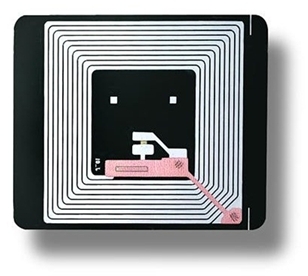 The 3M Basic RFID tag dimensions are 57mmX48mm. The 3M Basic RFID tag dimensions are 57mmX48mm.
Key
benefits:
-
No line of sight needed
-
Allows to check-out and check-in
several items simultaneously
-
Information directly attached to
product
-
Performing both identification and
antitheft in one single operation
-
Different shape and sizes
available
-
Able to tag almost anything
-
Accelerate scanning and
identifying
-
Most RFID tags are guaranteed for the
life of the item they’re affixed to.
RFID Conversion Station
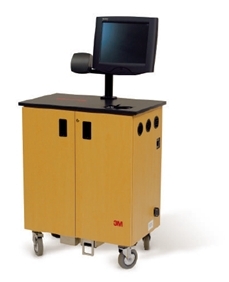
The 3M Conversion Station
provides a quick, easy solution for converting library materials to RFID technology. Featuring a touch-sensitive
screen, optical barcode scanner and RFID reader, this self-contained station rapidly reads barcodes, converts the
information and dispenses 3M™ RFID Tags. The station doesn’t require a connection to an automated circulation
system, and because it’s designed to be self-contained on a portable cart, it works right in the stacks. In
addition, the conversion station can reprogram RFID tags as items change.
3M Staff
Workstation
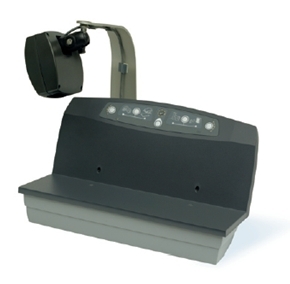
The 3M Staff
Workstation combines
item identification and security into a single operation. With its flexible design for improved ergonomics, the
workstation improves efficiency and increases productivity by processing both barcodes and RFID tags at checkout
and return. The workstation can also perform barcode-to-RFID conversions for new acquisitions and smaller scale
collections. The verifier light confirms the presence of a sensitized 3M tattle-tape security
strip.
Self-Check
System/Station
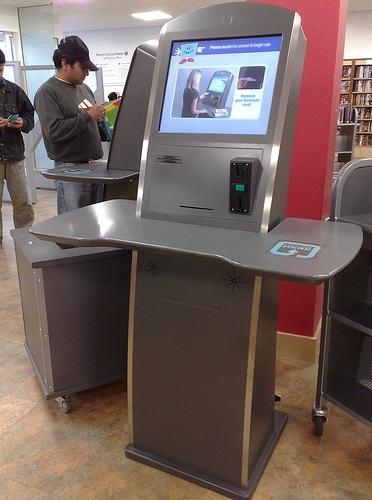 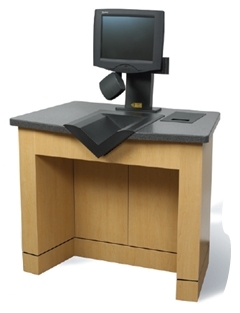
The Patron Self Check-out
station is basically a computer with a touch screen and a built-in RFID reader, plus special software for
personal identification, book and other media handling and circulation. After identifying the patron with a
library ID card, a barcode card, or his personal ID number (PIN), the patron is asked to choose the next action
(check-out of one or several books). After choosing check-out , the patron puts the book(s) in front of the
screen on the RFID reader and the display will show the book title and its ID number (other optional information
can be shown if desired) which have been checked out.
It is also possible
to use the station for Check-In (return) of books.
Key
benefits:
To Librarian:
To
Patrons:
Handheld Digital
Library Assistant
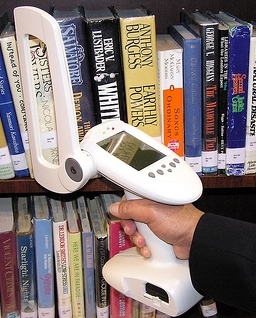 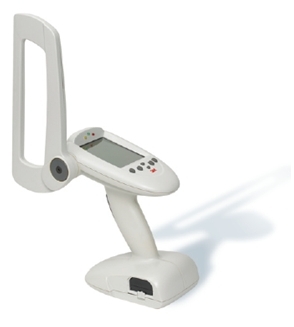
This cordless, 3M Handheld
Digital Library Assistantdevice instantly reads RFID tags on library materials, turning shelf-reading, shelving,
sorting, searching, weeding and exception-finding into routine tasks. Compact and easy to use, the Digital Library
Assistant can hold information on more than one million items.
It simultaneously performs
shelf-reading, searching and inventory scans, it can save time, increase productivity and discover errors that
might otherwise go unnoticed. The device can also quickly identify items that were not properly checked out, and
it instantly detects the security status of materials.
Anti-theft
Detection
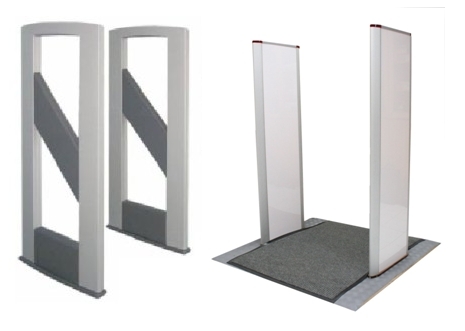
The RFID EAS Gate is the
anti-theft part of the RFID Library Management System using the same RFID tags embedded in the library
items.
The EAS Anti-Theft Gate is used
to detect RFID tag that is equipped with EAS (Electronic Article Surveillance). It can detect the RFID tags
within 1 meter range without interference of magnetic items, upon detecting of armed RFID tags, the alarm will
sound on the gate.
Theft detection is an integral
feature of the chip within the tag. It is usually a stand-alone technology, which operates independently of the
library database.
Features:
Key benefits:
-
Single technology is required for both
inventory and theft management of the library
-
Library staff are alerted immediately
when un-borrowed items pass through the theft detection gates
-
Would-be thieves are deterred by the
physical presence of the gates.
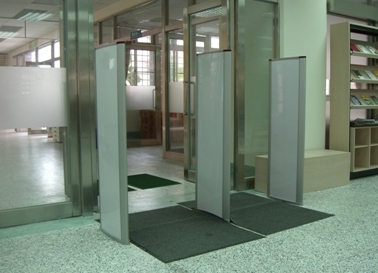
Conclusion
RFID technology promises to change our world. With RFID tags
inventory related tasks can be done in a fraction of the time needed by bar code readers/scanners. Security is
another aspect of library operations that may be greatly improved with RFID based security systems. Rather than
purchasing additional tags for security, a single tag can be used for identifying items and securing them. As
patrons leave the library, the tags are read to ensure that the item has been checked out. Librarians also report
that lost or hidden items are more easily retrieved using the portable readers. Yes, RFID technology in the library
speeds up book borrowing, monitoring, books searching processes and thus frees staff to do more user-service
tasks.
The reality is that libraries are
suffering from budget shortfalls as never before. With cuts to state and local governments, it is difficult for
libraries to keep the library staffed and open. However, as mentioned the use of such technology will drastically
reduce the cost of inventory control and shelf reading while enhancing the accuracy of inventory control and shelf
reading and the fact that RFID is becoming increasingly prevalent as the price of the technology
decreases.
The decision to for example cut
your library’s book budget to implement RFID will be difficult. If you do however make that decision the
libraries should be among the entities putting pressure on government and industry entities to develop
standards, public policy and best practices guidelines for its use.
Date: 24 April 2010
| 

 ABSA Bank
ABSA Bank FNB Bank
FNB Bank Standard Bank
Standard Bank Nedbank
Nedbank